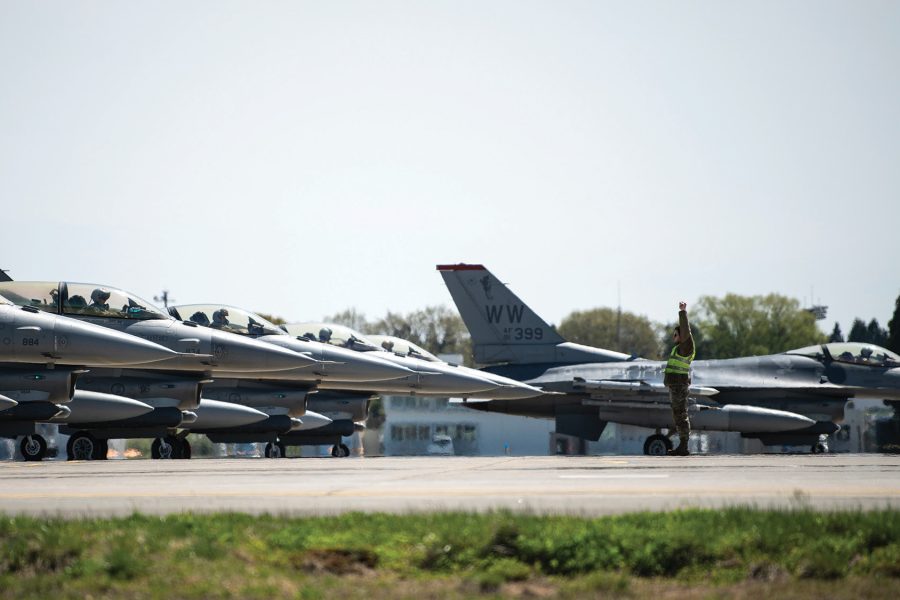A dozen F-16s from Misawa Air Base are joining back-to-back exercises across the Philippines’ vast archipelago, including the northernmost major island less than 200 miles from Taiwan.
The annual Balikatan exercise, currently underway from April 21 to May 9, features “full battle” drills spanning from the nation’s largest island, Luzon—home to the capital, Manila—to the southern reaches of Mindanao, and various islands in between. The training comes on the heels of Cope Thunder, an 11-day exercise between Pacific Air Forces and the Philippine Air Force that wrapped up April. 18.
A dozen F-16s from the 35th Fighter Wing were at Cope Thunder and have joined Balikatan, a PACAF spokesperson told Air & Space Forces Magazine. The move marks one of wing’s final large-scale exercises featuring its Fighting Falcons, as the Air Force will begin to withdraw the fourth-generation jets from northeastern Japan this summer.
In their place, the service plans to station 48 F-35s, up from the current F-16 fleet of 36, with the first stealth fighters expected to arrive in spring 2026, according to local media citing Japanese government officials. This will make Misawa the first U.S. base in the Indo-Pacific base to host the F-35A, and only the second overseas base overall, following in the footsteps of the U.K.’s RAF Lakenheath. The 35th Fighter Wing did not respond inquiries to confirm the timeline.

For Balikatan, cargo planes—including three C-130Js from the 317th Airlift Wing at Dyess Air Force Base, Texas; and one HC-130J from the 129th Rescue Wing at Moffett Federal Airfield, Calif.—supported the transportation of weaponry and personnel.
This year’s exercise involves 14,000 combined troops, with 9,000 U.S. personnel, including about 450 U.S. Air Force Airmen. It is the 40th iteration of Balikatan and features many firsts, including the participation of four NATO countries—Poland, Lithuania, the Czech Republic, and the Netherlands—as observers for the first time. And unlike past iterations, this year features a “full battle test” that adds real-world events to a virtual scenario.
“The Full Battle Test will demonstrate how the tactical actions of service members have operational effects for the multilateral force,” Marine Corps Lt. Gen. Michael S. Cederholm, commanding general, I Marine Expeditionary Force, said in a release. “Doing so allows us to validate, refine and improve our combined capability to defend the Philippines.”
In another first, the exercise incorporates the Navy-Marine ship-striking missile system NMESIS, as highlighted by Secretary of Defense Pete Hegseth during his visit to Manila last month.
The NMESIS combines a powerful missile mounted on a Joint Light Tactical Vehicle, which can be remotely operated, and will be deployed in Luzon and the Batanes Islands, just 120 miles south of Taiwan. The Air Force’s 29th Tactical Airlift Squadron, along with the Army’s 25th Combat Aviation Brigade, is helping transport several NMESIS across multiple islands in the region.
Meanwhile, Cope Thunder took place across several key locations, including Basa Air Base and Clark Air Base in Luzon. The 35th Fighter Wing’s F-16s teamed up with the Philippine Air Force’s FA-50PH, A-29B, S-76A, and S-70i aircraft for field training exercises. And for the first time in more than three-decade history of the exercise, the U.S. Marine Corps also joined the action with their F/A-18 Hornet fighters.
Originally launched in the Philippines in 1976, Cope Thunder moved to Eielson Air Force Base in 1992 before returning to the Philippines in 2023.
Amid these latest exercises, China issued a statement warning that it considers its dispute over Taiwan an “internal affair.” Beijing claims Taiwan as its territory, despite never having governed the island.
